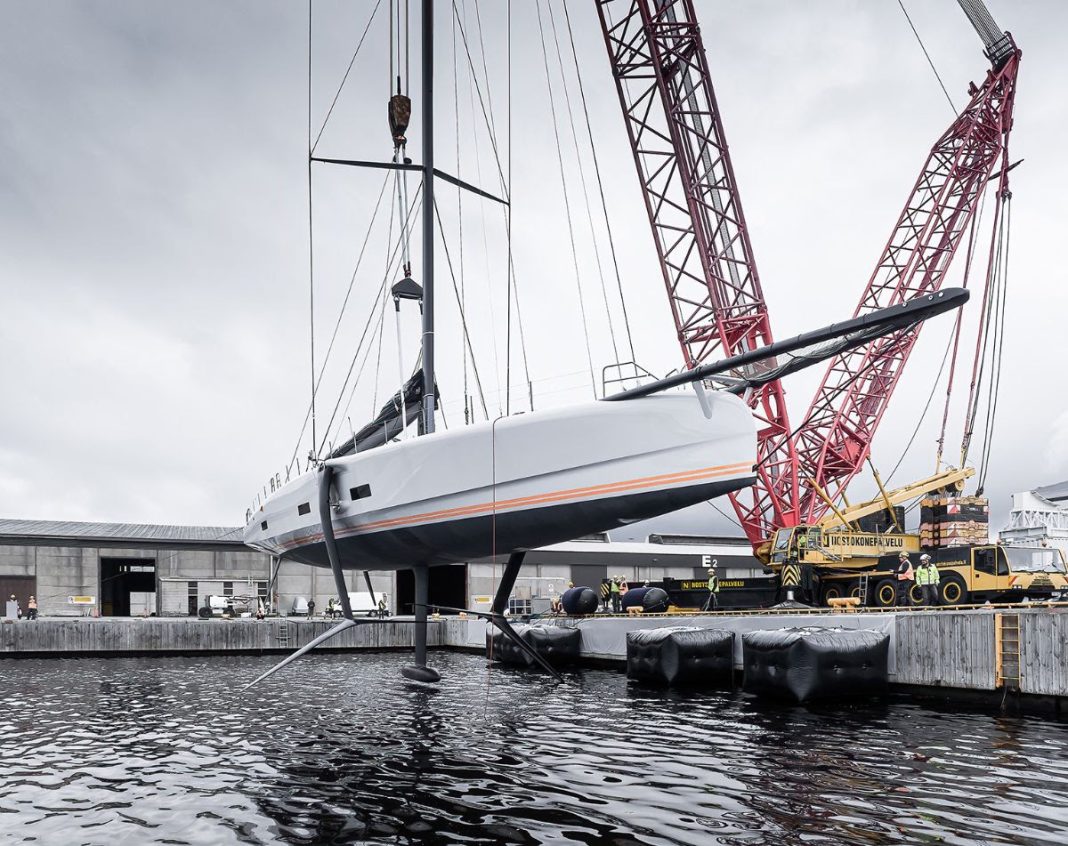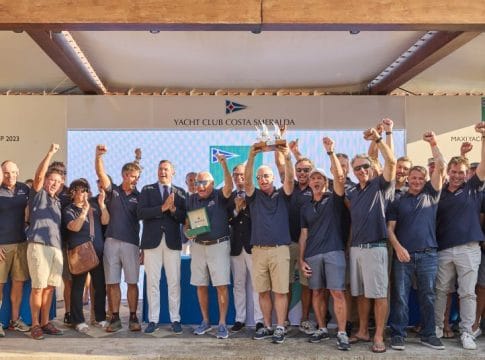As Raven prepares for her much-anticipated foil-assisted sailing trials, equal attention is being paid to her interior which combines dramatic styling and weight saving with the yacht’s structure and systems.
Baltic Yachts has officially launched the ultra-light, foil-assisted 111ft Raven in preparation for further sailing trials off Jakobstad in September, this time using her foils.
The ground-breaking yacht was first lowered into the water in mid-July, using her single point lift, minus her side arms and T-shaped hydrofoils, so that all her systems could be tested before foiling commenced.
This ensured that everything from her hydraulic, electrical and electronic systems, including her diesel electric propulsion were working. Her Southern Spars mast was stepped, North 3Di sails bent on and her water ballast tanks activated so that she could be assessed under sail without her foils. Although Raven is fitted with a fixed keel, without her foils she needs the assistance of water ballast to maintain stability while sailing.
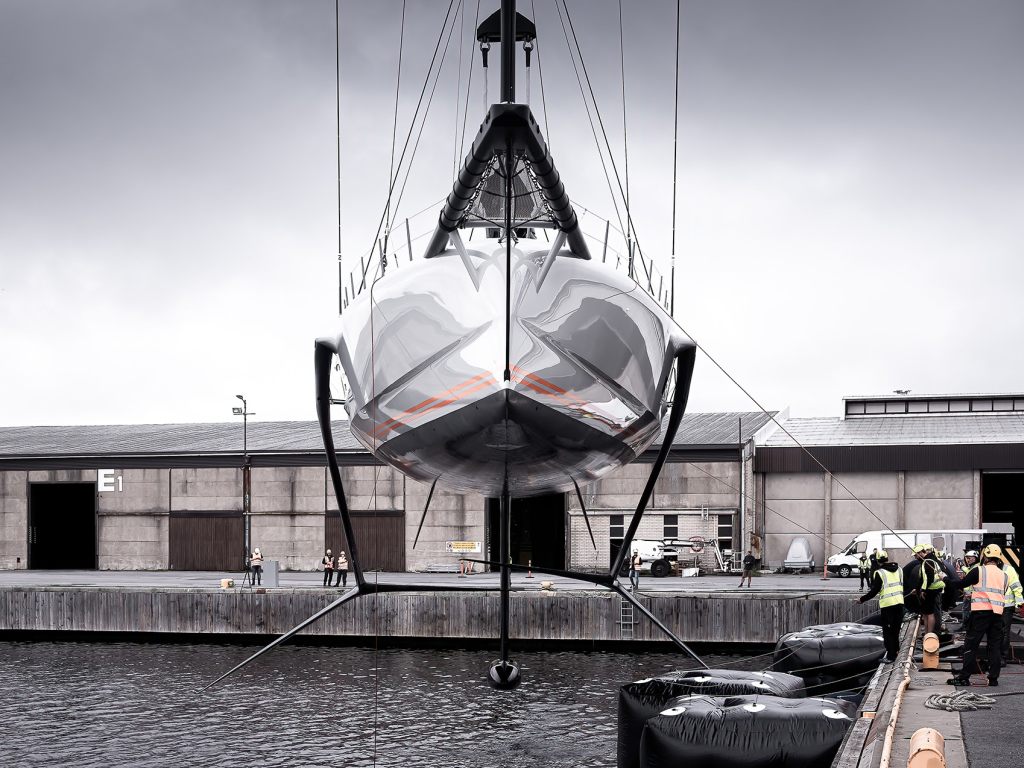
Baltic Yachts Executive Vice President Henry Hawkins said that initial trials had been successful and importantly they were on target with Raven’s lightship displacement.
With this phase of commissioning complete, Raven was recently lifted back onto the hard standing in Jakobstad so that her side arms and foils could be fitted and be prepared for further trials which will reveal her unique ability as a foil-assisted ultra-lightweight superyacht.
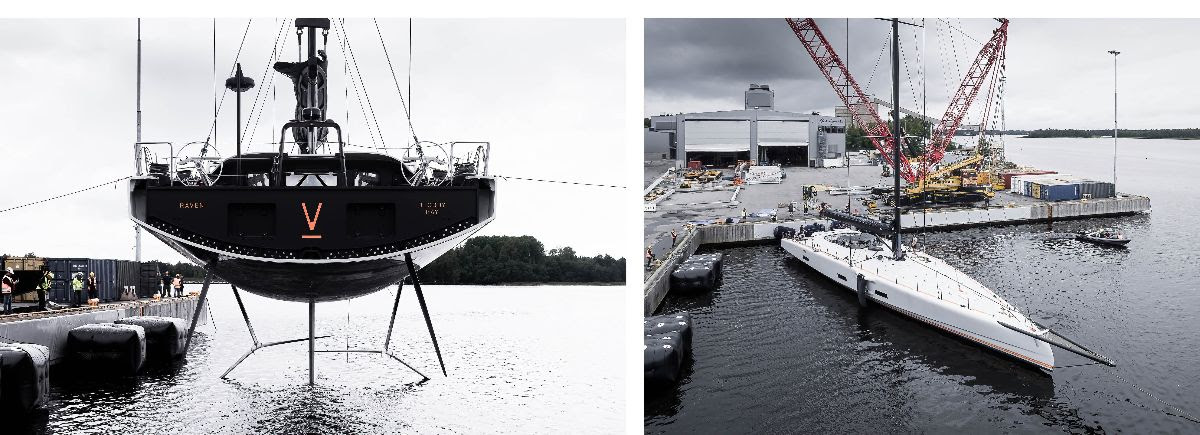
Above left, Raven, touches the water for the first time fully assembled. Above right, ready for her foil-assisted sailing trials
Photo credit: Tom van Oossanen
In the early part of September her specialist sailing team will join the yacht in Finland so that Raven can be gradually worked up to a level which will allow her to be shipped to a location where the conditions will enable her to reach her full sailing potential.
The sailing team is being managed by Klabbe Nylöf and will comprise a core crew of five, including skipper Damien Durchon, an experienced offshore sailor. There’s a shore-based technical team developing Raven continuously to help her reach full potential and during the training and test phase additional crew will be drawn in on rotation from a pool of 20 sailors with proven high-performance sailing experience.
The 111ft Raven is the most extreme sailing yacht Baltic Yachts has built, exceeding even the likes of Baltic 147 Visione and Baltic 197 Hetairos. She is the first superyacht in the world to use foiling technology in this way, has undergone one of the most intense weight-saving exercises her builder has ever completed, yet is fitted out with a stunning interior, which exposes the structure of the yacht to create a unique aesthetic.
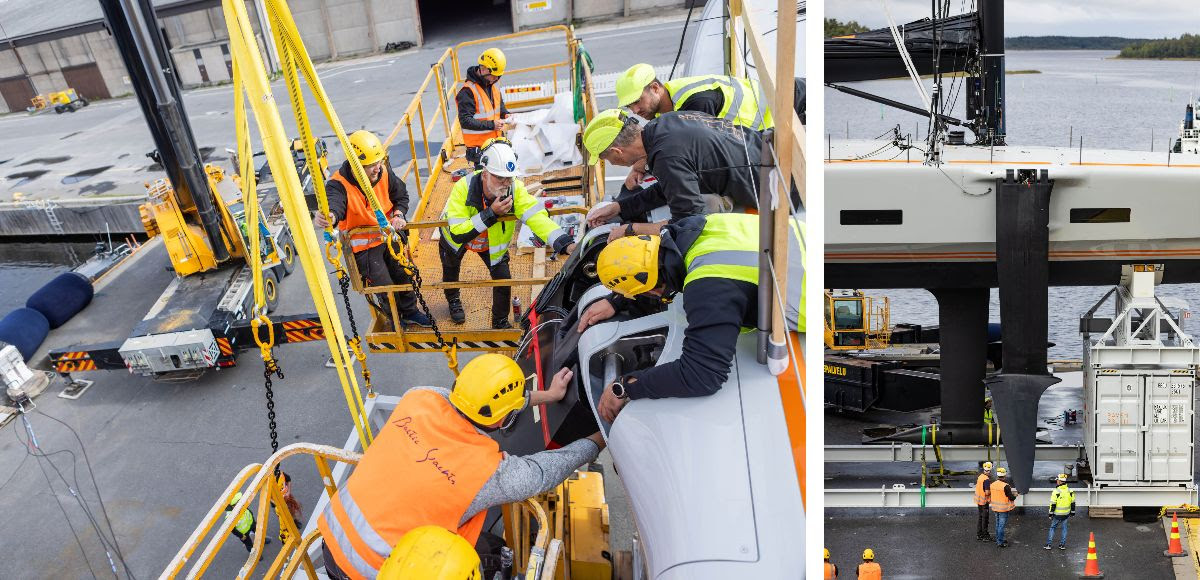
Baltic’s build team connect Raven’s side arms inserting the pin to complete the hinge mechanism. The side arms with their foils are moved by a large hydraulic ram directly below the hinge point
Photo credit: Eva-Stina Kjellman
The overall concept, including the interior and exterior styling is by Finn Jarkko Jämsén, whose renowned, disruptive thinking in superyacht design chimed with the owner’s desire for a stylish, quick, day-sailer superyacht with the ability to undertake high speed offshore passages. Naval architecture is by Botin Partners and structural engineering by PURE Design in New Zealand, both of whom are at the leading edge of the latest America’s Cup foiling designs.
Leading the Raven project is the highly experienced Garth Brewer of A2B Marine Projects who played a similar role with Visione and whose team has worked very successfully with Baltic Yachts to bring the project to fruition on schedule.
Baltic Yachts’ ability to drill down into the weight saving process and allow it to build a yacht with a fully-fitted out interior, enabled the foil-assisted part of the equation to be realised. The yacht’s hydraulically-operated side arms are fitted with T-shaped hydrofoils with trailing edge trim tabs adjusted to support about 60% of the yacht’s displacement at speed. The stern of the yacht will remain in the water, but is fitted with Interceptor vertical trim tabs which can adjust the fore and aft trim of the yacht.
Jämsén, design virtuoso
As the gradual process of realising Raven’s sailing performance begins, the focus of attention has been equally directed at the yacht’s striking outward appearance and the concept and styling of the interior, created by Jarkko Jämsén and his team.
Jarkko describes the design concept as ‘holistic’ in that the yacht’s exterior and interior have been designed to form a cohesive entity. The structure of the boat remains exposed in the interior and becomes part of the design exercise. “What is not normally visible is now on display,” says Jarkko. “There’s an aggressive, brutal side to some of the design like the carbon fibre structure itself, systems, the wiring and piping, with a thin layer of luxury in between,” he continued.
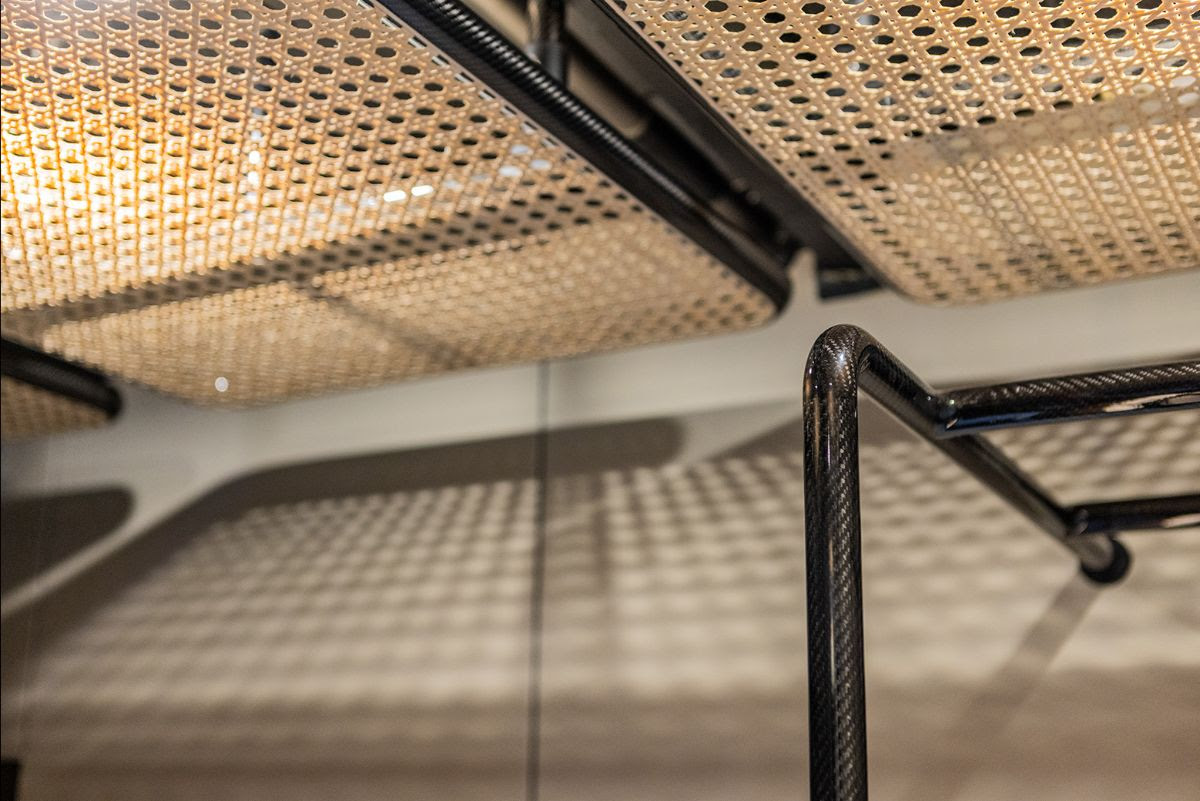

Top, ultra-lightweight carbon fibre tubular frameworks and rattan ‘panels’ are used extensively in the main accommodation areas. Above, left to right: crew accommodation uses more lightweight panelling to hide structure; clean, functional finish in the crew area; bulkheads in the main saloon are finished with a lightweight, rubberised material to absorb noise
Photo credit: Eva-Stina Kjellman
Coloured wiring looms, air conditioning trunking and ballast tank transfer pipes are exposed and embraced in the overall style. “Even under the floorboards the quality is perfect but with no gimmicks,” he said. “The design treatment is quite pure in that it uses the basic beauty of the systems in an unconventional way.”
The lay-out below and indeed on deck revolves around the extraordinary ‘bird’s nest’ cockpit design with its Perspex glazing and painted, timber-effect carbon fibre mullions paying tribute to the 1960s Maserati race car design which employed an exposed tubular space frame for weight saving and aesthetics.
The cockpit structure provides an abundance of natural light in the accommodation which comprises a master cabin aft with a centreline fold down double berth which stows against the forward athwartships bulkhead. Forward of the bird’s nest are extensive dining and seating areas to port and starboard, a galley to port and an aft facing navigation and control centre to starboard.
All the furniture is built on ultra-lightweight tubular carbon fibre carcasses with lightweight materials including rattan used in deckheads and landings for upholstery. Forward of the main saloon are head and shower compartments with visual access to the large hydraulic rams operating the hydrofoil side arms. There are further display panels set into the massive carbon fibre A frame mast support exposing the rams operating the upper and lower rig control deflectors and the downhaul for the 7m long reaching strut.
Unlike the saloon and master suite, the extensive crew accommodation forward is finished more conventionally with little of the yacht’s structure showing. In other words, Raven’s interior treatment is the exact opposite to tradition in which the owner’s areas tended to hide structure and crews’ quarters were left exposed.
A deck of many parts
The bird’s nest cockpit is located with the very conscious need to keep guests well clear of the working area of the yacht. It is also equipped with a fold-over ‘clam-shell’ hard bimini, paying tribute to another automotive classic, namely the hardtop of the 2005 Ferrari Super America. The bimini offers protection from the elements, of which windspeed while sailing will be a major consideration.
The yacht is controlled from an IMOCA-style, semi-covered working area aft with twin wheels and all sail control winches at the crews’ fingertips. The yacht’s distinctive reverse sheer and ‘droop-snoot’ bow not only aid visibility from aft when the yacht is in her foiling attitude, but are also aerodynamically as well as hydrodynamically more efficient at high speeds.
Perhaps counter-intuitively both cockpit soles are laid in solid teak which were carefully accounted for in the weight calculations. Raven’s side decks are heavily cambered when at rest, but with heel angle the windward surface becomes virtually flat allowing crew to move about more efficiently and safely.
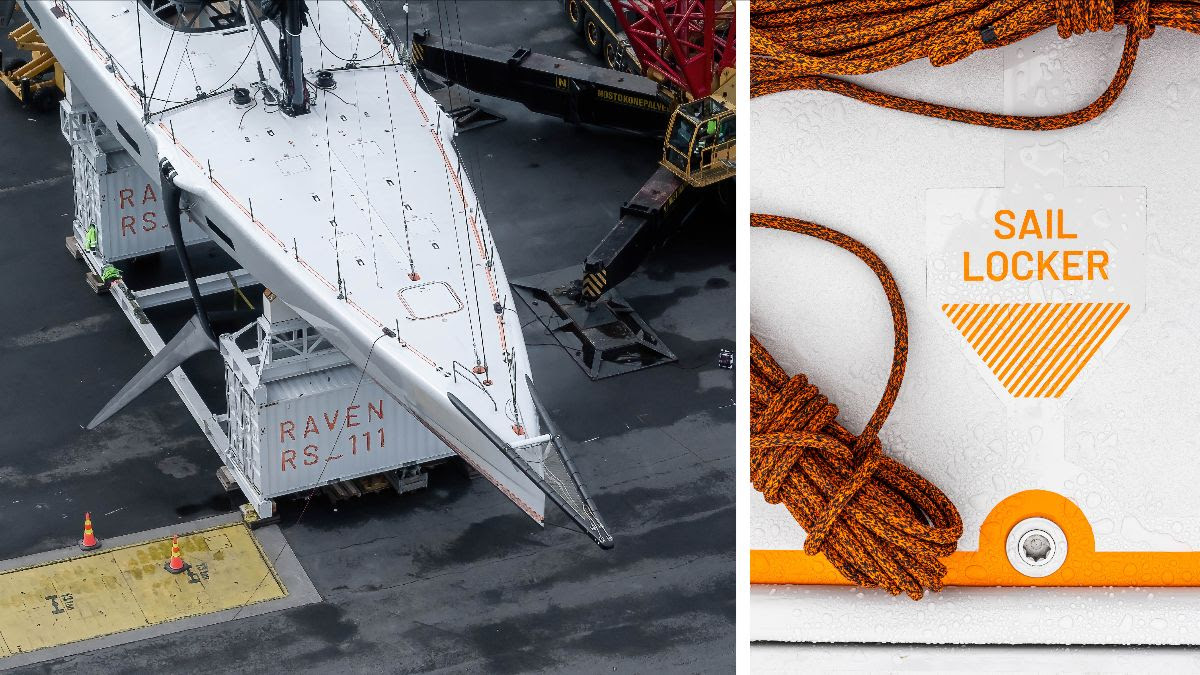
Left, Raven’s deck reveals a multitude of headsail options flown from deck tack points or her carbon fibre tubular bowsprit. Right, art meets practicality – to avoid confusion, deck hardware is labelled with hand-painted, non-slip signage
Photo credit: Tom van Oossanen, Eva-Stina Kjellman
“You know the markings on helicopter fuselages?” asked Jarkko Jämsén. “Well, we’ve used the same sort of thing here as a communication tool if you like.” Each deck fitting, whether it’s a winch, a pad eye or hatch fastening dog is provided with an orange, hand-painted, non-slip ‘instruction’ as to its function. Even the drum winches have arrows indicating the direction of travel and there’s some familiar colloquial language used for some controls born out of the confusion that sometimes reigns in the pit of race yachts.
In short, Raven, is a remarkable study in functional and aesthetic design overlaying the most advanced sailing systems ever seen in a superyacht.
Her sailing performance is another story altogether and one which will be revealed in due course.
Jarkko Jämsén
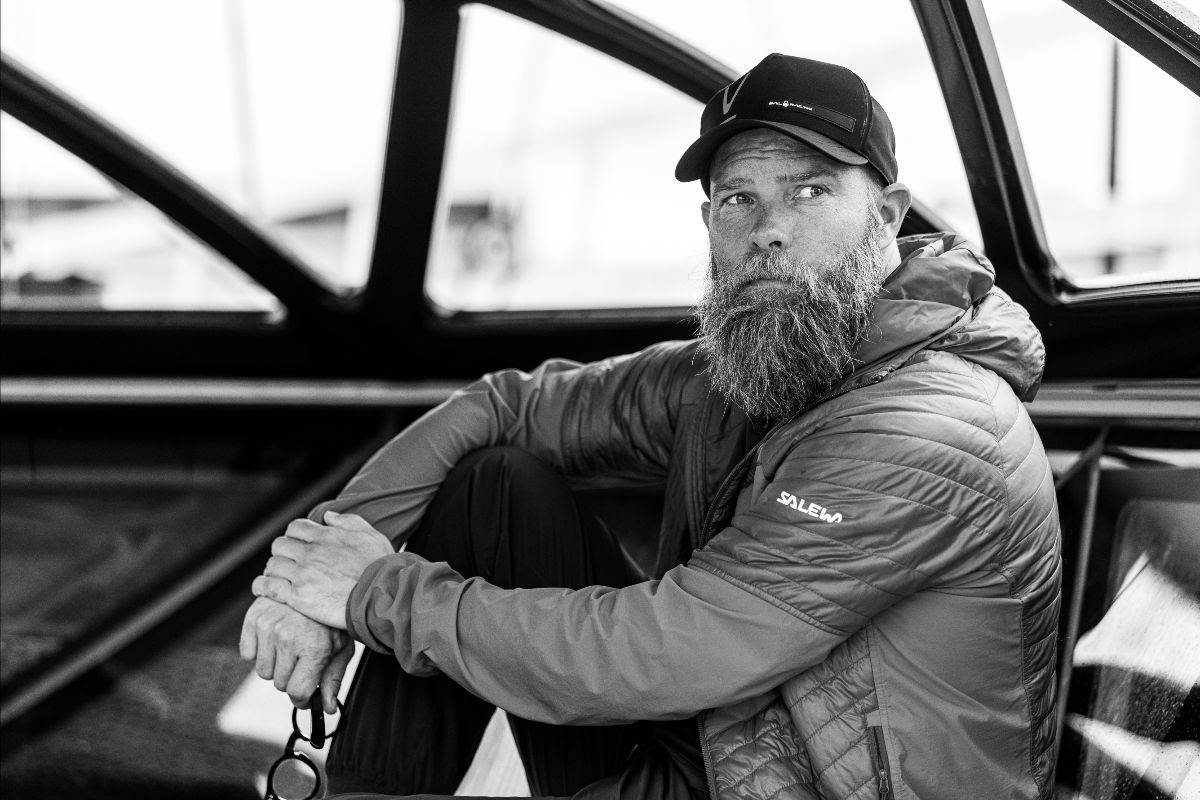
Jarkko Jämsén has used his ability to combine industrial design with interior and exterior styling in an exceptional way with the Raven project
Photo credit: Eva-Stina Kjellman
Jarkko Jämsén could be described as a marine design polymath using his deeply enquiring mind and fertile artistic creativity to produce some of the most remarkable yachts of our time. He’s a founding partner of the award-winning Finnish design company Aivan, one of the biggest multi-disciplinary design studios in the Nordic countries with more than 90 employees. Navia Design is the marine arm of Aivan and Jarkko runs his own design agency Jamsen srl out of Monaco. Some of Jarkko and his team’s stand out marine products include the hugely successful Axopar powerboat range – he designed the stepped hull as well as being responsible for the styling – and the exterior styling for the 77m Feadship 818 Pi. With degrees in naval architecture, industrial design and wooden boat building, he uses his skills to mix interior and exterior style with industrial design, and in Raven he has demonstrated that ability to its full extent. He appreciates that much modern design owes its existence to successes from other eras. He’s a big fan of Nat Herreshoff who developed the 10m catamaran Tarantella almost 150 years ago in the USA and reminds us that in the 1950s Gordon Baker designed a foiling monohull for the US navy which could sail at 30 knots on wooden foils hand-cranked into position! Some of the fundamentals of modern design might not be new but Jarkko Jämsén is certainly taking them to another level.


